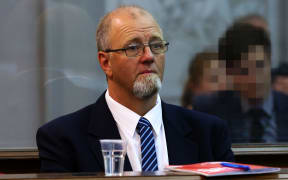The defence has dismissed as meaningless 423km the police say murder accused Mark Lundy travelled but failed to account for.

Mark Lundy on the first day of his trial. Photo: RNZ / Alexander Robertson
Mr Lundy, 56, has pleaded not guilty to murdering his wife and daughter, Christine, 38, and Amber Lundy, whose bodies were found in their Palmerston North home on 30 August 2000. His retrial, before Justice Simon France and a jury of seven men and five women, is in its second week in the High Court in Wellington.
The Crown contends he killed his wife for her insurance money, and his seven-year-old daughter because she saw what he was doing to her mother.
Key points from day nine of the trial
On the opening day of the trial, the Crown contended Mr Lundy's car mileage and empty petrol tank showed a "secret trip" - a round trip to Palmerston North to kill his family.
Police analyst Mary Ellwood told the court today Mr Lundy's car had 80,589km on the odometer when it was serviced on 21 August. That had risen to 81,859 when it was seized on 30 August - a difference of 1270km.
However, Mr Lundy had travelled known distances of only 847km during that eight days, leaving 423km unaccounted for, Ms Ellwood said.
Ms Ellwood analysed Mr Lundy's credit card transactions and cellphone calls, as well as relying on his statements, to track his movements, she said.
But defence lawyer Julie-Anne Kincade this afternoon dismissed the analysis as "meaningless", saying it failed to take into account Mr Lundy's movements around New Plymouth and Palmerston North for five of those nine days.
"The fact is there's a great deal that is unknown during that period," Ms Kincade said.
"... It's very meaningless, isn't it."
Ms Ellwood disagreed, saying almost a third of the travel was unaccounted for, "so it's still not explicable, 423km".
Earlier today, Sergeant Danny Johanson told the court he was tasked with seeing how long it took to drive from Petone to Palmerston North, and how much fuel was used. He also took trips to record the distance.
It was made clear to him he would not be exempt from speed camera tickets and he was not to put public safety at risk during the trips.
Defence lawyer Julie-Anne Kincade asked whether he slowed down in 50km/h zones.
"On all of these trips, because of the case theory last time, you were trying to do them as quickly as you could," she said.
Mr Johanson said he "definitely slowed down but I may have been exceeding the speed limit".
However, he never went above 140kmh, he said.
Mr Johanson said when he was travelling under the worst conditions possible when he was recording fuel consumption; the air conditioning was on full, he was accelerating so heavily his foot was on the floor, and he was braking heavily.
"Just drove the vehicle hard in general ... it was hard driving."
"It was hardly a scientific sort of experiment," he said.
Ms Kincade yesterday asked Mr Johanson to confirm he used 76.1 litres of fuel to visits the businesses Mr Lundy had been to, drive back up to Palmerston North, back to Petone and then return to Palmerston North.
He agreed that it was 76.1 litres - prompting Ms Kincade to point out Mr Lundy's petrol tank had a capacity of only 68 litres.
Ms Kincade also contended Mr Johanson had not visited all the businesses Mr Lundy had during his business trip, and that he would have used even more petrol if he had.
"There were a few places missed out," she said.
"The actual distance Mr Lundy must have done would have been more than what you did."
Mr Johanson disagreed and said even if he had missed some places, they were in the same area as the ones he had visited.
Mr Lundy drove a 1998 Ford Falcon AU and a police officer yesterday gave evidence he had been unable to siphon petrol out of it without breaking a flap in the fuel neck.
Gareth Townend, of Courtesy Ford in Palmerston North, today said that model car was fitted with a spring-loaded flap in the fuel filler. It was designed to be an anti-splash valve but was known as an "anti-siphoning valve" because attempts to siphon petrol from the car would usually break the valve.
However, on cross-examination from Ms Kincade, Mr Townend said petrol could be siphoned from that model of car by inserting a piece of wire to hold the flap open while a hose was put in and out.
Ms Kincade also put it to Mr Townend the Australian Green Guide, which gives fuel economy figures for a range of vehicles, did not bear any resemblance to "real world driving".
"I would agree to a point. They're within cooee. They're not grossly exaggerated," he replied.
However, he agreed with Ms Kincade that hard accelerating and high speeds were the two factors which had the biggest effect on fuel consumption.
* Clarification - For the avoidance of doubt, please note that Radio New Zealand reporter Sharon Lundy is no relation to Mark Lundy.





